|
|
||||
|
Published by : PROFESSIONAL MEDICAL PUBLICATIONS |
||||
|
ISSN 1681-715X |
||||
|
||||
|
|
||||
|
- |
||||
|
ORIGINAL ARTICLE |
||||
|
- |
||||
|
Volume 25 |
July - September 2009 |
Number 4 |
||
|
|
||||
|
||||
rK39 enzyme-linked immunosorbent assay for the
diagnosis of Kala-azar in an endemic zone of Bangladesh
M. Abdus Salam1, Dinesh Mondal2, Mamun Kabir3, Rashidul Haque4
Abstract
Objective: The diagnostic role of rK39 enzyme linked immunosorbent assay (ELISA) was compared with the buffy-coat Leishmania nested polymerase chain reaction (Ln-PCR) for kala-azar in an endemic zone of Bangladesh.
Methodology: This evaluation study included 100 cases comprising of 60 clinically suspected patients of kala-azar and 40 healthy controls. Anti-rK39 antibody was estimated in plasma by ELISA and buffy coat was utilized to detect Leishmania DNA by Ln-PCR from both patients and controls. The diagnostic role of rK39 ELISA was then compared with Ln-PCR positive cases which were considered as confirmed cases of kala-azar.
Results: Out of 60 suspected patients of kala-azar, 58 (96.67%) were found positive in ELISA against 56 (93.33%) of Ln-PCR-positive cases. Further, 55 (98.21%) of ELISA-positive patients were also found positive in Ln-PCR. Voluntary healthy controls (40) included 20 persons from the endemic zone and 20 from non-endemic zone of kala-azar, were all found negative in both Ln-PCR and rK39-ELISA. The sensitivity and specificity of ELISA were found to be 98.21% and 95.65% respectively.
Conclusion: rK39-ELISA is a non-invasive serodiagnostic tool for visceral leishmaniasis with very high sensitivity and specificity.
KEY WORDS:
Visceral leishmaniasis, Kala-azar, rK39-ELISA, Ln-PCR, Sensitivity, Specificity.Pak J Med Sci July - September 2009 Vol. 25 No. 4 635-640
How to cite this article:
Salam MA, Mondal D, Kabir M, Haque R. rK39 enzyme-linked immunosorbent assay for the diagnosis of Kala-azar in an endemic zone of Bangladesh. Pak J Med Sci 2009;25(4):635-640.
1. Dr. Md. Abdus Salam, M.Phil (Microbiol.),
M.Sc (UK)
Assistant Prof., Dept. of Microbiology,
Rajshahi Medical College, Rajshahi 6000, Bangladesh.
2. Dr. Dinesh Mondal, PhD
Assistant Scientist, Parasitology Laboratory,
ICDDR,B, Dhaka, Bangladesh.
3. Mamun Kabir, M.Sc
Research Officer, ICDDR, B
4. Dr. Rashidul Haque, PhD
Head, Parasitology Laboratory, ICDDR, B,
Dhaka, Bangladesh.
Correspondence
Dr. Md. Abdus Salam, M.Phil (Microbiol.), M.Sc (UK)
Assistant Prof. of Microbiology, Rajshahi Medical College,
Rajshahi-6000 – Bangladesh.
E-mail: drsalamrmc@yahoo.com
* Received for Publication: November 1, 2008
* Accepted: June 25, 2009
Introduction
Visceral leishmaniasis (VL) or kala-azar is a vector borne parasitic disease caused by Leishmania donovani complex.
1 Interhuman transmission of this disease occurs in the Indian subcontinent with the female sandfly of the genus Phlebotomus as the vector. The disease is geographically and ecologically widespread threatens 350 million people worldwide with 500,000 new cases of visceral leishmaniasis every year.2 Surprisingly, India, Bangladesh and Nepal together account for 60% of all reported VL cases in the world.3 Available reports show that many parts of Bangladesh are endemic for the disease with the current prevalence is estimated to be 45,000 cases and out of 64 districts, at least 34 districts including 105 upazillas have been reportedly affected by kala-azar.4 Kala-azar carries a high mortality rate ranging from 80% to 100% and even with treatment, case fatality rates in excess of 10% are common.5Isolation of the parasite in culture or demonstration in relevant tissues like spleen, bone-marrow or lymph node by light microscopic examination of the stained specimen remains "gold standard" and naturally, leads to the definitive diagnosis of visceral leishmaniasis.
6 But the diagnostic potential of conventional smear or culture techniques is limited with low sensitivity particularly in detecting the occult and sub-clinical infections. Moreover, these techniques are also cumbersome, time consuming and not suitable for field condition. The development of Polymerase Chain Reaction (PCR) has provided a powerful approach to the application of molecular biology techniques to the diagnosis of leishmaniasis. PCR assay with buffy coat preparations to detect Leishmania DNA has been found to be 10 times more sensitive than that with whole-blood preparation.7 But unfortunately, sophisticated machines, trained personnel and cost are limiting factors for PCR as a routine diagnostic test for kala-azar. With the consequence, the scope and reliability of specific serological tests like the Enzyme Linked Immunosorbent Assay (ELISA) for the diagnosis of VL is enormous. However, the sensitivity and specificity of ELISA is greatly influenced by the antigen used.Recently, several recombinant antigens like rGBP from L. donovani, rORFF from L. infantum, rgp63, rK9, rK26 and rK39 from L. chagasi have been developed and tested.
8-13 Of these, the rK39 antigen has been found to be highly sensitive and predictive of the onset of disease manifestation in VL patients. A kinesin-related protein encoding gene has been discovered in L. chagasi that contains a repetitive 117-bp sequence encoding 39 amino acid residues (K39) conserved at the C-terminal end in all of the VL-causing isolates examined so far.14 The recombinant product of K39 (rK39) has been proven to be very sensitive and specific antigen used in ELISA for the serodiagnosis of VL in different endemic foci.Early correct diagnosis of kala-azar is imperative as the treatment is of long duration and can be complicated with many side effects. In the present study, an attempt was made to evaluate the diagnostic performance of rK39 ELISA as a non-invasive tool for kala-azar in an endemic area of Bangladesh.
Methodology
Clinically suspected patients of visceral leishmaniasis (60) of different age and sex were admitted at different Medical and Paediatric wards of Rajshahi Medical College Hospital (RMCH), Bangladesh. Apparently healthy persons of comparable age and sex without having past history of prolong fever, splenomegaly or other clinical features suggestive of visceral leishmaniasis served as controls (40). Among the controls, twenty (20) were from non-endemic and twenty (20) from endemic areas of kala-azar. Taking all aseptic precautions, 5.0 ml of blood was collected into an EDTA containing clean test tube from all patients and controls.
Laboratory tests for rK39 ELISA and Ln-PCR were done at the Parasitology Laboratory of ICDDR,B, Dhaka, Bangladesh.
Ln-PCR for the detection of parasite DNA in the buffy coat
Collection of Buffy coat and DNA extraction:
After 30 minutes of collection of blood it was centrifuged @ 4000 rpm for 20 minutes. Using tip of the micropipette, 500µl of buffy coat was aspirated from the top of the centrifuged deposit and was kept into a 1.5ml microcentrifuge tube to be preserved at – 200C for PCR amplification. DNA extraction from the buffy coat was performed according to the procedure of Qiagen blood DNA extraction methods.15Protocol for Ln-PCR
Primers used:
The kinetoplastida-specific primers R221 52 - GGTTCCTTTCCTGATTTACG-32 , and R332 52 -GGCCGGTAAAGGC CGAATAG-32 were used in 1st PCR andR223 52 -TCCCATCGCAACCTCGGTT-32 and R333 52 -AAAGCGGGCGCGGTGCTG-32 were used in the nested PCR.
PCR amplifications were performed with BioRad My Cycler and DNA fragments of 353 bp were amplified using nested PCR protocol as described by Curz et al.
16 The amplified products were visualized on UV illuminator in 2% agarose gel stained with ethidium bromide. A 100 bp DNA ‘ladder’ was used as a molecular size marker. A positive sample yielded a PCR product of 353 bp. In all assays, molecular grade water was used as blank, normal blood DNA as negative control and DNA from cultured promastigotes served as positive control (Fig-1).
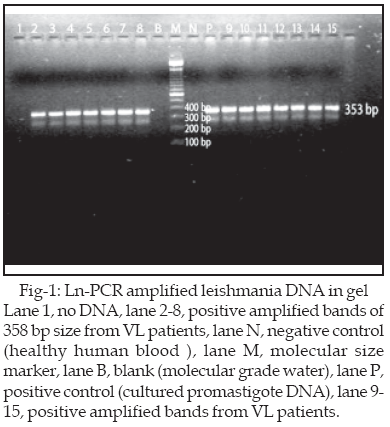
rK39- ELISA for the detection of anti-leishmanial antibodies in plasma: ELISA was performed using ELx 808 Microplate Reader and automatic washer (Bio-Tek Instruments, Inc, USA) for all 60 patients and 40 controls according to the standard protocol of rK39 ELISA for Leishmania.17 The cut-off value of ELISA for antibody concentration was taken as 60AU (Arbitrary Unit). Any value above 60 AU was considered as positive for ELISA (Fig-2&3).
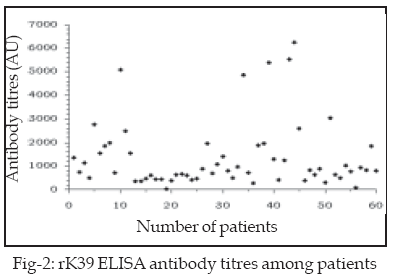
Case definition:
Ln-PCR- positive for DNA were considered as confirmed cases of kala-azar.Ethical consideration:
The protocol of this study was approved by the ‘Institutional Review Committee’ of Rajshahi Medical College, Bangladesh for ethical issues related to this research. Informed written consent was obtained from each patient or from the legal guardian and control before venipuncture to collect blood.
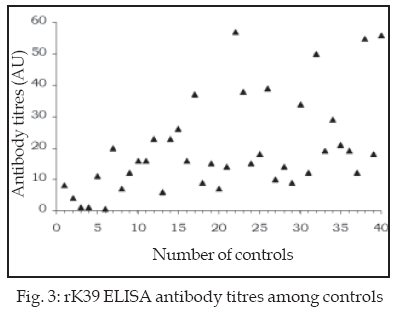
Statistical Analysis:
The sensitivity and specificity were calculated by using the following formulae:Sensitivity = Number of samples with
true-positive results (a) x 100
Number of samples with true-positive results (a) + Number of samples with false-negative results (c)
Specificity = Number of samples with
true-negative results (d) x 100 Number of samples with true-negative results (d) + Number of samples with false-positive results (b)
Results
Patient’s characteristics: Forty four were male and 16 were female. Median age of the patients was 25 years with quartile 14-35. All patients had splenomegaly and chronic fever with a median duration of four months. Other common symptoms such as history of weight loss and darkening of skin were found in 98.33% and 95% of the patients respectively (Table-I).
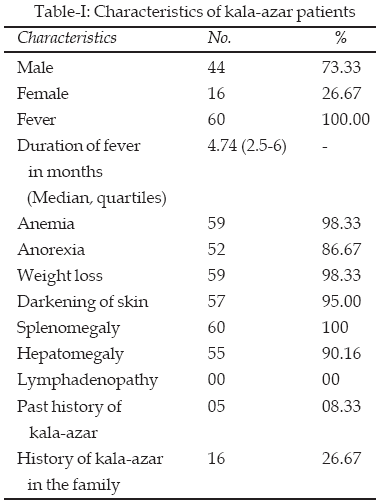
Laboratory results of patients and controls: Table-II shows the results of Ln-PCR and ELISA among study population. Out of 60 suspected patients of kala-azar, Ln-PCR was found positive in 56 (94.33%) cases and remaining 04 (05.67%) were negative, while ELISA was positive in 58 (96.67%) and negative in 02 (03.33%) patients. All controls were found negative for both Ln-PCR and ELISA. Among the ELISA-positive cases, 55 (98.21%) patients were also found positive for Ln-PCR indicating its sensitivity to be 98.21%.
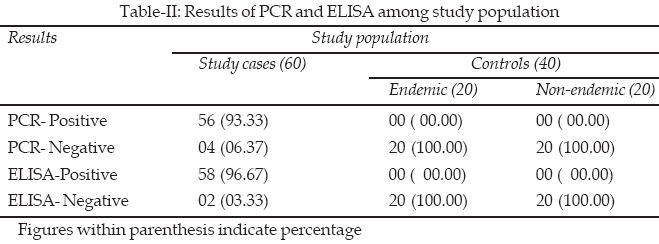
Antibody titres of 60 AU (Arbitrary unit) were taken as cut-off value for ELISA and titres above 60 AU were considered as positive scores. Among 58 ELISA positive cases, 35 (60.34%) had titres within 1000 AU, and 23 (39.66%) had above 1000 AU (Fig-2). While antibody titres of all controls were found below the cut-off value of 60 AU (Fig-3).
DISCUSSION
Visceral leishmaniasis continues to be an important public health problem with significant morbidity and mortality in the endemic areas. The clinical and epidemiological findings of leishmaniasis are non pathognomonic and these can mimic several other conditions. Improved diagnosis is of crucial importance for any attempt to control visceral leishmaniasis in the endemic areas. The low sensitivity of smear or culture technique for detection of L. donovani has urged researchers to shift the priority towards molecular and immunological techniques for obvious reasons.
We have performed rK39 ELISA for the detection of anti-leishmanial antibodies in the plasma for 60 clinically suspected patients of kala-azar and its diagnostic performance was compared with Ln-PCR detection of Leishmania DNA in buffy coat. The Ln-PCR positive cases were considered as confirmed cases of kala-azar in this protocol. Due to its very high diagnostic sensitivity and specificity, the PCR-based molecular diagnostics has been accepted as confirmatory test for visceral leishmaniasis as reported by many authors.
18-20 Out of 60 suspected patients of kala-azar in this series, rK39 ELISA was found positive with titres >60 AU in 58 (96.67%) against 56 Ln-PCR positive cases, while all controls were found negative by both ELISA and Ln-PCR (Table-II). When performance of ELISA was compared to Ln-PCR, it was seen that 55 (98.21%) of ELISA-positive cases were also found positive in Ln-PCR. The sensitivity and specificity of ELISA in this study were found to be 98.21% and 95.65% respectively. As far as the diagnostic validity and rate of case detection are concerned, similar results of rK39 ELISA were also noted in a few studies conducted in India.21,22 The high rate of case detection by ELISA in this study could be due to the use of rK39 antigen which has been found to be more specific than crude soluble antigen (CSA).The 02 ELISA-positive but Ln-PCR negative cases noted in the present study may be considered as false positive cases because of its potential inherent property of detecting anti-leishmanial antibodies which might be present in the detectable range even after 24 months of successful treatment of VL cases.
23 As a whole the high rate of case detection in this study can be correlated with enrollment of patients with strong clinical suspicion and endemicity.In conclusion, it can be said that, rK39 ELISA for the diagnosis of kala-azar is a unique tool reported by many investigators and has also been validated by the present study carried out in a kala-azar endemic zone of Bangladesh. Further, due to its very high sensitivity and specificity, rK39 ELISA can be considered as an appropriate alternative tool to parasitological or nucleic acid-based diagnosis for kala-azar. Although not suitable for field practice in its present settings but it can be well adapted as a reliable non-invasive serodiagnostic tool for the secondary or tertiary care centres.
References
1. Leishman WB. On the possibility of occurrence of trypanosomiasis in India. BMJ 1903;1:1252-4.
2. UNAIDS: AIDS Epidemic Update 2002.
3. Murray CJL, Lopez AD. Global Health Statistics: A Compendium of Incidence, Prevalence and Mortality Estimates for Over 200 Conditions. Murray CJL, Lopez AD, eds. Global Burden of Disease and Injury Series. 1996, Vo II. Boston: Harvard University Press.
4. Laboratory diagnosis of Kala-azar (Visceral Leishmaniasis) with the Direct Agglutination Test (DAT) - A training module for laboratory Technician, Published by M&PDC & IEDCR, DGHS, 1996.
5. Indu B, Ahluwalia, Bern C. Visceral leishmaniasis: Consequences of a neglected disease in a Bangladeshi community. Am J Trop Med Hyg 2003;69(6):624-8.
6. Sundar S, Rai M. Laboratory diagnosis of visceral leishmaniasis. Clin Diag Lab Immunol 2002;9(5):951-8.
7. Lachaud L, Chabbert E, Dubessay P, Reynes J, Lamothe J, Bastein P. Comparison of various sample preparation methods of PCR diagnosis of visceral leishmaniasis using peripheral blood. J Clin Microbiol 2001;38:613-17.
8. Montoya Y, Leon C, Talledo M, Nolasco O, Padilla C, Munoz-Najar U, et al. Recombinant antigens for specific and sensitive serodiagnosis of Latin American tegumentary leishmaniasis. Trans R Soc Trop Med Hyg 1997;91:674-6.
9. Martin SK, Thuita-Harun L, Adoyo-Adoyo M, Wasunna KM. A diagnostic ELISA for visceral leishmaniasis, based on antigen from media conditioned by Leishmania donovani promastigotes. Ann Trop Med Parasitol 1998;92:571-7.
10. Jensen AT, Gasim S, Moller T, Ismail A, Gaafar A, Kemp M, et al. Serodiagnosis of Leishmania donovani infections: assessment of enzyme-linked immunosorbent assays using recombinant L. donovani gene B protein (GBP) and a peptide sequence of L. donovani GBP. Trans R Soc Trop Med Hyg 1999;93:157-160.
11. Rajasekariah GH, Ryan JR, Hillier SR, Yi LP, Stiteler JM, Cui L, et al. Optimisation of an ELISA for the serodiagnosis of visceral leishmaniasis using in vitro derived promastigote antigens. J Immunol Methods 2001;252:105-119.
12. Raj VS, Ghosh A, Dole VS, Madhubala R, Myler PJ, Stuart KD. Serodiagnosis of leishmaniasis with recombinant ORFF antigen. Am J Trop Med Hyg 1999;61:482-7.
13. Bhatia A, Daifalla NS, Jen S, Badaro R, Reed SG, Skeiky YA. Cloning, characteri-zation and serological evaluation of K9 and K26: two related hydrophilic antigens of Leishmania chagasi. Mol Biochem Parasitol 1999;102:249-61.
14. Burns JM Jr, Shreffler WG, Benson DR, Ghalib HW, Badaro R, Reed SG. Molecular characterization of a kinesin-related antigen of Leishmania chagasi that detects specific antibody in both African and American visceral leishmaniasis. Proc Natl Acad Sci USA. 1993;90:775-90.
15. Quagen Inc., Valencia, CA, Cat. No. 51106; http:/www.qiagen.com
16. Curz I, Canavate C, Rubio JM, Morales MA. A nested polymerase chain reaction (Ln-PCR) for diagnosing and monitoring Leishmania infantum infection in patients co-infected with human immunodeficiency virus. Trans R Soc Trop Med Hyg 2002;96:185-9.
17. Kumar R, Pai K, Sundar S. Enzyme-linked immunosorbent assay for recombinant K39 antigen in diagnosis and prognosis of Indian visceral leishmaniasis. Clin Diag Lab Immunol 2001;8:1220-24.
18. Fisa R, Riera C, Ribera E. A nested polymerase chain reaction for diagnosis and follow-up of human visceral leishmaniasis patients using blood samples. Trans R Soc Trop Med Hyg 2002;96(Suppl. 1):191-4.
19. Pizzuto M, Piazza M, Senese D. Role of PCr in diagnosis and prognosis of visceral leishmaniasis in patients coinfected with human immunodeficiency virus type 1. J Clin Microbiol 2001;39:357-61.
20. Maurya R, Singh RK, Kumar B, Salotra P, Rai M, Sundar S. Evaluation of PCR for Diagnosis of Indian Kala-azar and Assessment of Cure. J Clin Microbiol 2005;43(7):3038-41.
21. Choudhry A, Guru PY, Suxena RP, Tandon A, Suxena KC. Enzyme-linked immunosorbent assay in the diagnosis of kala-azar in Bhadohi (Varansi), India. Trans R Soc Trop Med Hyg 1990;84:363-366.
22. Gupta S, Srivastava JK, Ray S, Chandra R, Srivastava VK, Katiyar JC. Evaluation of enzyme-linked immunosorbent assay in the diagnosis of kala-azar in Malda district (West Bengal). Indian J Med Res 1993;97:242-6.
23. Zijlstra EE, Daifalla NS, Kager PA, Khalil EAG, El-Hassan AM, Reed SG, et al. rK39 Enzyme-Linked Immunosorbent Assay for Diagnosis of Leishmania donovani Infection. Clin Diag Lab Immunol 1998;5:717-20.
